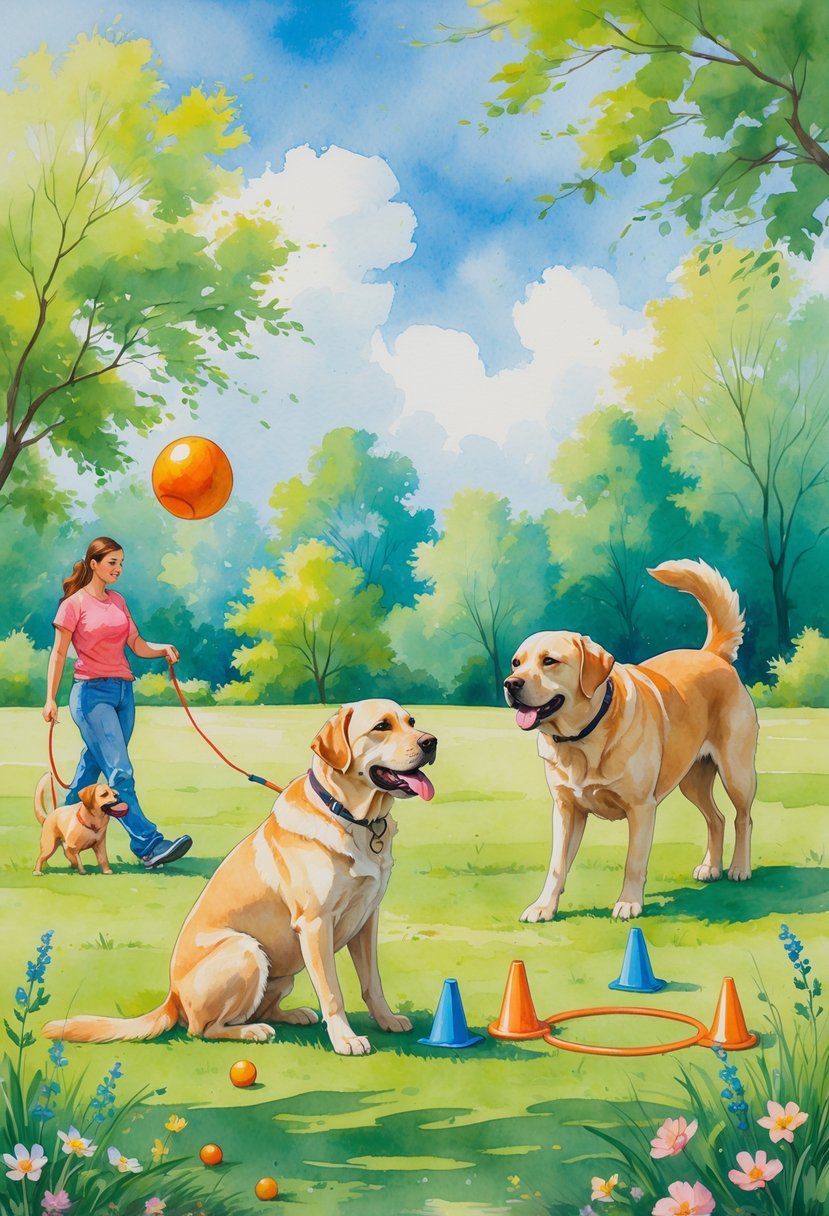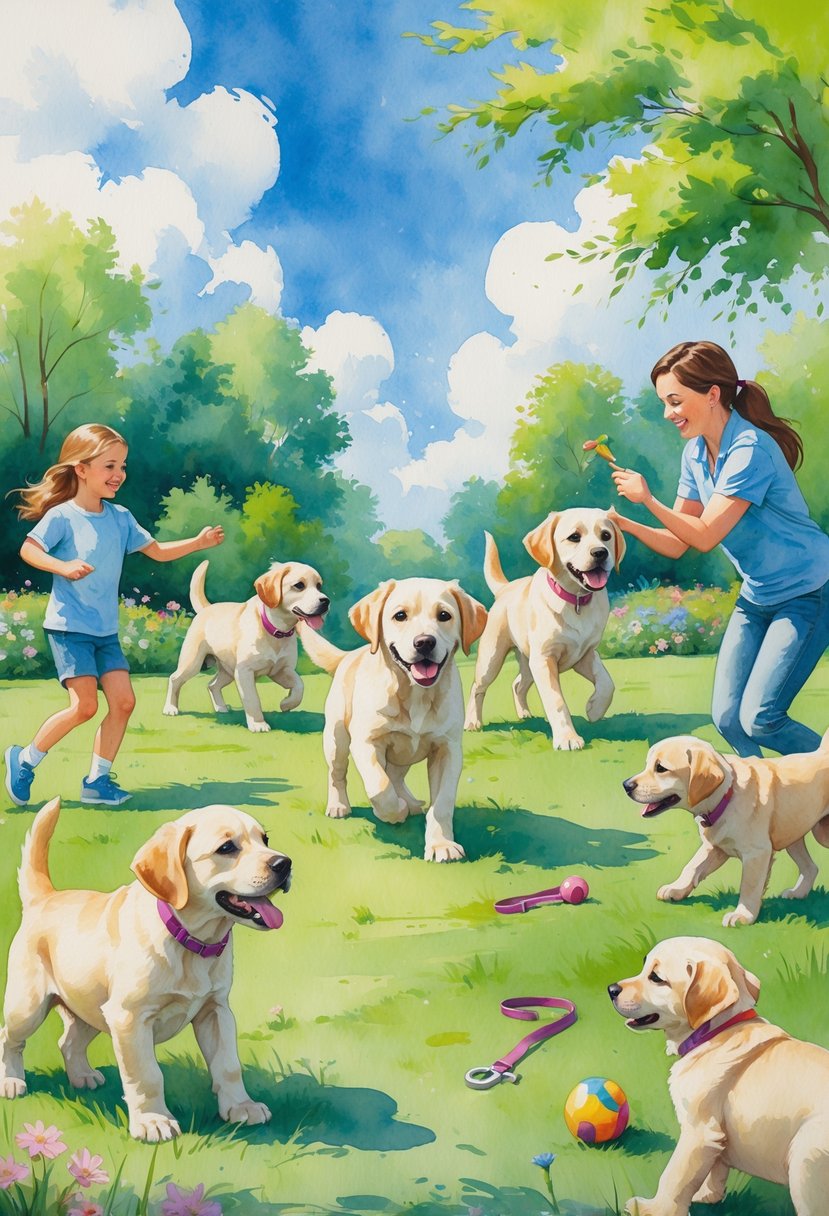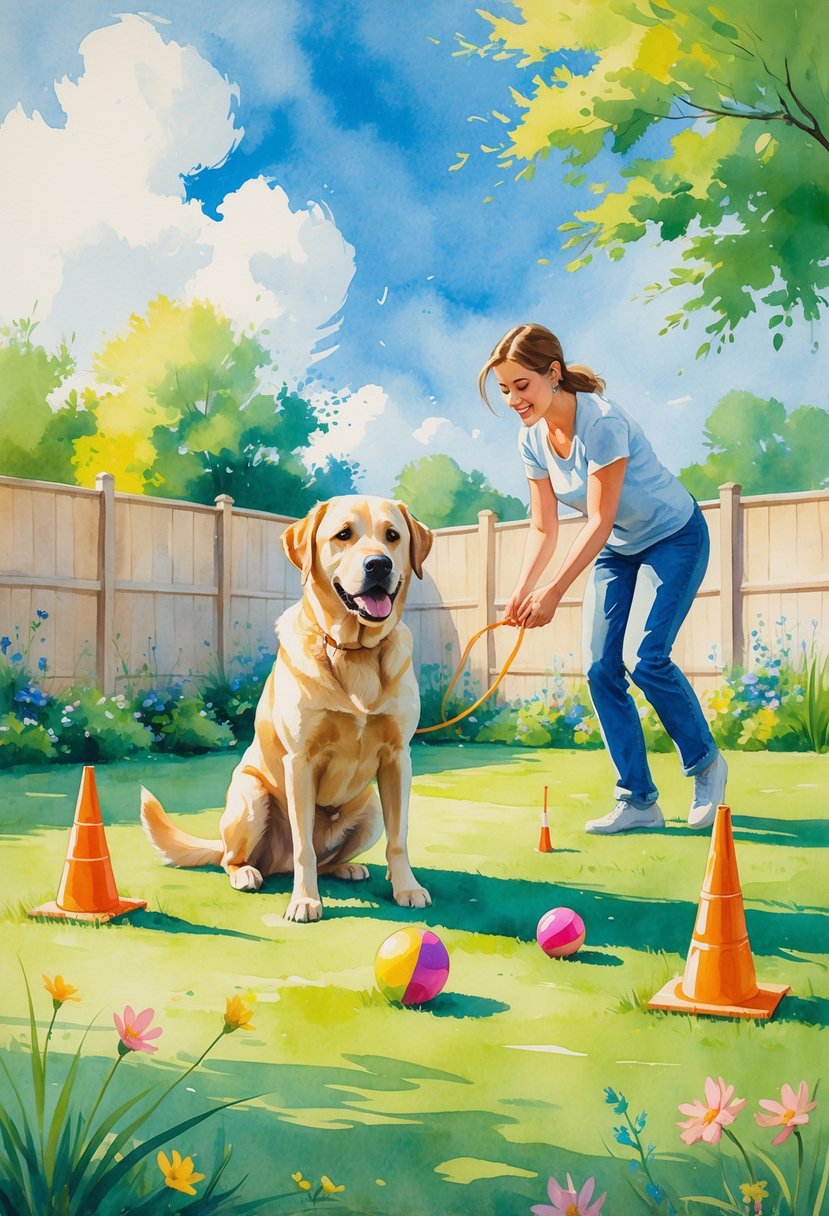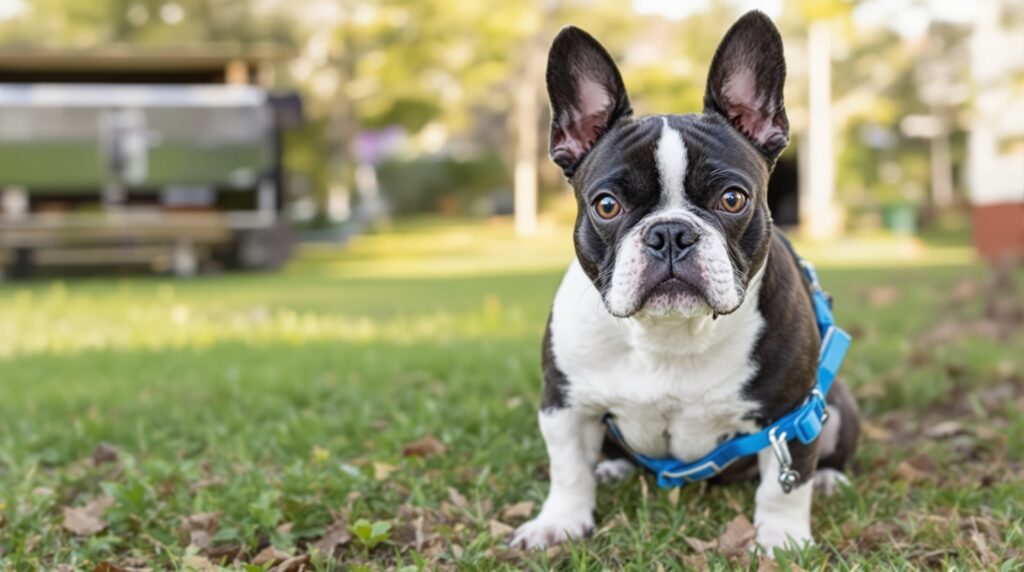Labradors are bursting with energy, and that energy can either drive you nuts or help you raise a well-behaved companion.
If you learn how to channel that drive into training, you’ll turn all that excitement into progress and focus.
Instead of fighting against their enthusiasm, you can use it to build skills and strengthen your bond.

You know how quickly a Labrador gets distracted or restless if there’s not enough to do.
With the right mix of exercise, structure, and positive reinforcement, that same excitement becomes motivation to learn.
By steering their energy in the right direction, you’re setting up better behavior at home and calmer walks.
Training sessions start to stick, and honestly, everything feels a bit easier.
Key Takeaways
- Channel natural energy into training for better focus
- Build structure with consistent routines and clear guidance
- Strengthen learning through rewards, patience, and practice
Understanding Labrador Energy and Temperament
Labrador Retrievers have a built-in drive for activity and interaction.
Their energy comes from their working-dog roots, and learning how to manage it helps you guide their behavior and prevent frustration.
Why Labradors Are So Energetic
Labradors were bred as working dogs to retrieve game and help fishermen.
That’s why they have so much stamina and a constant need for movement.
Your Labrador often thrives when they have a “job,” whether that’s fetch, obedience drills, or agility.
Without enough outlets, you’ll see unwanted behaviors like chewing or digging.
They’re also super social.
A Labrador is happiest when included in daily activities, whether it’s a walk, training session, or just playtime.
Their social nature fuels their enthusiasm and makes them quick learners when you provide structure and consistency.
Recognizing Signs of Excess Energy
When your Labrador has too much energy, you’ll see it in their behavior.
Common signs include:
- Restlessness: pacing or constant movement
- Chewing: going after furniture, shoes, or toys
- Jumping: greeting people with wild excitement
- Vocalization: barking or whining for attention
These aren’t signs of a “bad dog.”
They’re just signals your Lab needs more physical or mental exercise.
Pay attention to when these behaviors pop up.
If your dog chews at night, maybe their daytime activity wasn’t enough.
Spotting patterns helps you tweak their routine before things get out of hand.
Tailoring Activities to Individual Labrador Needs
Not all Labradors burn energy the same way.
Age, health, and personality play a big role in what works best.
- Puppies: Short play sessions, basic obedience, simple fetch games
- Adults: Longer walks, swimming, running, or agility courses
- Seniors: Gentle walks, scent games, low-impact play
Think about your Lab’s temperament, too.
A high-drive retriever may need fast-paced games like running or dock diving.
A calmer dog might prefer puzzle toys or slow hikes.
Matching activities to your Labrador’s needs keeps them balanced and reduces stress.
It also makes training more effective.
Establishing a Consistent Exercise Routine

A Labrador stays healthier and calmer when you give them steady physical activity and mental challenges.
Regular walks, active play, and a mix of exercise options help manage their energy and cut down on unwanted behaviors.
Daily Walks and Play Sessions
Your Lab needs daily walks to burn energy and stay balanced.
Aim for at least 30–60 minutes of activity, depending on age and health.
Puppies usually need shorter, more frequent outings.
Adults can handle longer sessions.
Mix in play like fetch, tug-of-war, or hide-and-seek.
These games work their body and keep their mind busy.
Toys that encourage chasing or retrieving tap into their instincts.
Keep walks structured but fun.
A steady pace helps with endurance, and breaks for sniffing add mental stimulation.
Try to walk at the same times each day so your Lab knows what’s coming.
Swimming and Outdoor Adventures
Labradors are natural swimmers, and water activities give them a safe, low-impact workout.
Swimming builds strength without stressing joints, which is great for young and older dogs.
Bring a floating toy to encourage water retrieving.
Outdoor adventures like hiking, trail running, or visiting dog parks add variety.
They expose your Lab to new sights, smells, and challenges, which helps prevent boredom.
Always keep safety in mind.
Use a leash or long line on hikes, and watch your dog closely when swimming.
If your Lab is new to water, start in shallow spots and build confidence slowly.
Balancing Physical and Mental Stimulation
A Labrador needs more than just physical exercise.
Mental stimulation helps prevent restlessness and destructive habits.
Training sessions, puzzle feeders, and scent games let your dog think and problem-solve.
Try short training drills during walks—like practicing “sit” at crosswalks or “stay” before crossing the street.
This blends obedience with exercise.
Use interactive toys that release treats, or hide food around the house for your Lab to find.
Balancing body and mind keeps your dog satisfied and makes training easier.
Incorporating Positive Reinforcement Techniques
Labradors learn best when you focus on clear, consistent rewards for the behaviors you want.
By using food, toys, and praise the right way, you create a strong bond and make training fun.
Rewarding Good Behavior
Reward your Labrador the moment they show the behavior you want.
Timing matters—a reward only works if it happens right away.
Keep rewards simple and steady.
If your Lab sits when asked, give a treat or praise immediately.
If you wait, they might get confused.
Make sure you reward only the behavior you want.
If your Lab jumps up and you give attention, even if it’s negative, you might encourage the wrong thing.
Stick to rewarding calm, controlled responses.
Use the same command words and gestures every time.
This helps your dog learn faster and keeps training clear.
Using Treats, Praise, and Play
Labradors love food, so treats are often the easiest tool for training.
Use small, healthy pieces so you don’t overfeed.
Praise matters, too.
A cheerful “good job” can motivate your dog as much as food.
Pairing praise with treats makes the reward even stronger.
Play can be just as rewarding.
A quick game of fetch or tug-of-war after a correct response gives your Lab both exercise and positive feedback.
This works especially well for high-energy dogs.
Change things up between treats, praise, and play.
It keeps training interesting and stops your Lab from relying on just one reward.
Avoiding Negative Reinforcement
Skip punishment-based methods like yelling, hitting, or harsh collars.
They can create fear and make training way harder.
Instead, redirect unwanted behavior.
If your Lab chews on furniture, hand them a toy and reward them for using it.
Sometimes, ignoring minor unwanted behaviors works.
If your dog barks for attention, don’t respond until they’re quiet—then reward the silence.
Consistency and patience make positive reinforcement work way better than punishment.
You’ll build trust and keep your Labrador eager to learn.
Mastering Obedience Training for Labradors
Obedience training helps your Labrador stay safe, behave well, and respond quickly to you.
By focusing on clear commands and regular practice, you can guide your dog from simple instructions to advanced skills.
Teaching Basic Commands
Start with short training sessions—about 10–15 minutes.
Labradors have loads of energy, but they also learn quickly if lessons are fun and rewarding.
Use positive reinforcement like small treats, toys, or praise.
The first commands to teach are sit, stay, come, and down.
These create a base for safety and control.
For example, “stay” keeps your Lab from rushing out the door, while “come” brings them back even with distractions.
Keep your tone upbeat and consistent.
Always use the same word for each command, and reward right away when your dog responds.
If they lose focus, just pause and try again later.
A simple progression:
- Sit → Have them sit before meals.
- Stay → Start with a few seconds, then build up.
- Come → Call them from short distances first.
- Down → Use for calm behavior indoors.
Building Advanced Skills
Once your Lab responds to basics, move to more challenging obedience work.
Advanced training gives them mental stimulation and deepens your bond.
Heel training teaches your Lab to walk calmly by your side.
This is super helpful for such a strong breed.
Use a short leash and reward them for staying close.
Off-leash recall is another key skill.
Practice in a safe, enclosed area with few distractions.
Gradually increase distance and difficulty, rewarding every time they return.
Other advanced skills include leave it, place, and wait at doors.
These commands help manage your Lab’s curiosity and excitement.
You can add agility or scent work to obedience practice, too.
These activities keep your Labrador engaged and reinforce listening.
By mixing physical exercise with training, you give your dog both structure and fun.
Leash Training for Safe and Enjoyable Walks

Teaching your Labrador to walk calmly on a leash helps prevent accidents and makes outings more enjoyable.
By focusing on steady leash manners and discouraging pulling or jumping, you set up safer, more relaxed walks for both of you.
Loose-Leash Walking Techniques
Start indoors or in your yard where there aren’t many distractions. Clip on the leash and reward your Labrador whenever the leash stays slack.
Use small, soft treats and a cheerful marker word like “yes” to reinforce good steps. Keep sessions short—about 5–10 minutes—so your dog doesn’t lose interest.
Gradually increase the number of steps before rewarding, going from one step to a few. This helps your Labrador see that staying close and calm pays off.
When you head outside, pick a quiet spot first. Let your dog sniff a little, but reward them for checking in with you.
A 4–6 foot non-retractable leash and a well-fitted harness give you more control and help protect your dog’s neck. If your Labrador gets distracted, try games like “follow me.”
Step back and encourage them to come toward you. It turns walking into a bit of a game and keeps the leash loose.
Preventing Pulling and Jumping
Labradors are strong, and if they think pulling works, they’ll drag you everywhere. The main rule? Loose leash = go, pulling = stop.
Stand still when your dog pulls, and only walk again once the leash slackens. Teach attention cues like “look at me” or “touch” so they have something to focus on when they get excited.
Reward calm responses right away. Jumping is common when Labradors greet people, so ask for a “sit” before letting them say hello.
If you always reinforce calm greetings, you won’t have to deal with jumping as a habit. When your Labrador is bursting with energy, give them a quick game of fetch or tug before training.
A little exercise first takes the edge off and makes leash practice smoother.
Early Socialization for Confident Labradors

Early socialization helps your Labrador Retriever build confidence and handle new experiences. If you give your dog safe exposure to different places, people, and animals, you lower the risk of fear or weird behaviors later on.
Introducing New Environments
Labrador puppies really benefit from seeing a mix of settings while they’re young. The window between 3 and 14 weeks is key for early socialization, so use this time to show them safe, new environments.
Start with easy spots like your yard or a friend’s house. As your puppy gets braver, add short trips to pet-friendly parks, quiet streets, or even just car rides.
Keep outings upbeat and short so your dog doesn’t get overwhelmed. Bring treats or a favorite toy to reward calm behavior.
If your Labrador looks stressed—maybe crouching or refusing to move—pause and let them watch until they relax. Don’t force them into anything scary.
A simple checklist can help:
| Environment | Goal | Example Activity |
|---|---|---|
| Home | Comfort with sounds | Run vacuum while offering treats |
| Outdoors | Adapt to movement | Watch bicycles from a distance |
| Car | Reduce travel stress | Short rides with praise |
Encouraging Positive Dog and Human Interactions
Meeting people and other dogs is just as important as new places. Labradors should learn that calm, polite behavior earns rewards during social encounters.
Start by introducing your puppy to people of different ages, appearances, and voices. Let visitors allow your dog to approach on their own terms.
Reward sitting quietly instead of jumping up. When meeting other dogs, pick calm, vaccinated buddies.
Begin on neutral ground with both dogs leashed. Watch for relaxed body language like loose tails and gentle sniffing.
If things get tense, back off and try again later. Puppy classes can help too—they’re great for safe, structured play and teaching basic manners.
With enough positive experiences, your Labrador learns how to greet politely, share space, and feel good around others.
Setting Boundaries and Creating Structure

Labradors thrive when they know what to expect and where their limits are. Clear rules and calm routines help channel their energy in good ways and stop habits like jumping or pulling from taking over.
Establishing Consistent Rules
Your Labrador learns best when rules stay the same every day. If you let them jump on you sometimes but not other times, they’ll never really get it.
Consistency builds trust and makes training easier. Decide early which behaviors are okay and which aren’t.
For example:
- Furniture access – always allowed or never
- Meal times – feed on a schedule, not whenever they beg
- Walking rules – leash manners every walk
Use simple commands like sit or down before giving rewards. That way, your Lab learns that calm behavior gets them attention, food, or play.
Everyone in the house should follow the same rules. If one person ignores bad behavior while another corrects it, your Lab will just get confused.
A shared approach keeps training clear and fair—at least, as much as possible!
Managing Excitement in the Home
Labradors have a reputation for their wild enthusiasm, especially when they greet people. If you don’t manage this energy, it can turn into jumping, barking, or zooming around the house.
Try to stay calm yourself. If you raise your voice or rush around, your Lab will just get more excited.
Ignore the jumping. Reward your dog only when all four paws are on the floor.
Set up routines that help your dog settle down. For example, ask them to sit before you open the door.
You can also use a mat or bed as a “calm spot.” Sometimes, giving them a chew toy or a puzzle feeder during busy moments really helps.
Structured greetings and quiet spaces guide your Lab to handle excitement better. Isn’t it nice when calm behavior finally gets them what they want—your attention?


